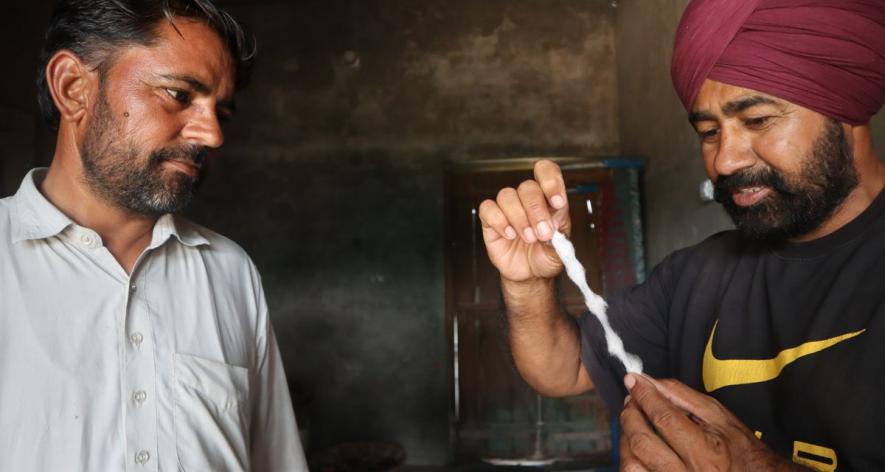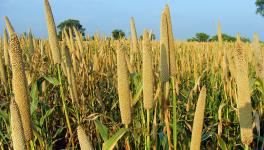Punjab: Slow Yet Steady, Farmers Pave Way for Revival of Organic Desi Cotton

Plant of organically grown cotton (Photo - Sanskriti Talwar, 101Reporters)
Balwinder has another two acres of low-lying land where water-intensive crops such as rice and sugarcane thrive with the help of canal water and a tubewell. These crops are sold in the local mandis (marketplaces) for more reliable prices than his organic cotton.
Balwinder sought to reconnect with traditional farming methods after taking over the land from his elder brothers on his retirement from the Indian Army. “I wanted to plant these seeds not only to grow nutritious fodder for a desi cow I was planning to buy, but also to improve the diet of my family, including my wife who is diabetic and two daughters,” says Balwinder.
Balwinder distinctly remembered the traits of kaali kapas that his father used to grow when he was a teenager. “Its leaves would turn dry when the crop matured. It was less prone to diseases and required less water. It thrived even on plots at higher elevations that were difficult to irrigate,” he recalls.

Farmer Balwinder Singh at his farmland in Punjab (Photo - Sanskriti Talwar, 101Reporters) .
So in February this year, Balwinder travelled 100 km to Dhingawali in Fazilka district, where he sourced the authentic indigenous cotton seeds from Surendra Pal Singh, whose family has been cultivating the crop for five generations.
“I have shared these seeds with farmers in Punjab, Rajasthan and Haryana,” says Surendra (62), whose family land totalling 300 acres is divided among three brothers. Their primary reason for growing indigenous cotton is to make oil cake from its seeds to keep their over 100 cows in good stead.
Eighty acres are dedicated to organic farming, where the family grows both indigenous and American cotton (narma) on about three to 12 acres, and sorghum, pearl millet, legumes and citrus fruits. “In most cases, farmers switched to organic farming due to a health condition in the family. But we prioritise flavour, taste and aroma because we have always eaten food grown in our fields,” says Surendra.
However, Surendra and his family still grow Bt cotton using chemical farming methods on about 50 to 90 acres. That plot is at a distance from where they do organic farming. “It is out of helplessness that we grow it. How else do we survive in the business of farming? We did not shift to paddy as only a small amount of canal water reaches this tail-end area.”
The sandy soil beneath his feet reflects the characteristics of this semi-arid region, which shares borders with Rajasthan to the south and Haryana to the east. The local language, Bagri, is a blend of Rajasthani, Haryanvi and Punjabi, along with vocabulary influenced by Marathi and Gujarati.
The big shift
Cotton has traditionally been grown in southern Punjab, particularly in Bathinda, Mansa, Fazilka and Sri Muktsar Sahib. Originally, indigenous cotton (desi kapas) was widespread across these regions. With its shorter fibres, it was ideal for household pillows, quilts and mattresses. Narma, which offered higher yields and longer fibres that suited the textile industry, was introduced in the mid-20th century.
It quickly became the dominant crop, but large-scale monoculture made it highly susceptible to pests, especially the cotton bollworm. Farmers increasingly relied on chemical pesticides, which initially controlled pests but eventually led to resistance.
The later introduction of Bt cotton — genetically modified to resist bollworms — provided temporary relief, but soon faced resistance from pink bollworms. With yields declining, many shifted to crops with high market demand and minimum support prices (MSPs). Earlier, cotton cultivation in Punjab ranged between nine to 14 lakh acres, peaking at 18 lakh acres in 1988-89. However, by 2022-23, it had plummeted to nearly six lakh acres.
“Muthi bhar kisan hi hai vo bhi muthi bhar hi ye fasal laga rahe hai,” says Kanwarjit Singh Brar (42) of Udekaran in Sri Muktsar Sahib, highlighting that only a handful of farmers grow cotton.
“A farmer can earn up to Rs 1 lakh per acre from growing Basmati rice, whereas he earns only about Rs 30,000 per acre from growing cotton, be it organic or Bt,” he details. The market value for all cotton grown whichever way are the same at just over Rs 7,000 per quintal.
Brar manages 32 acres across three plots, practising organic farming on 4.5 acres where he grows citrus fruits, fodder crops, and a small patch of indigenous cotton (about 0.25 acre) mainly as green manure for wheat.
Balwinder still considers the lower yield of two quintals from his rain-fed kaali kapas far more advantageous, primarily due to the absence of chemical inputs. He notes that it could have reached three quintals with just one more rainfall.
Organically grown desi kapas and narma typically provide a yield of five to eight quintals per acre. For chemically grown Bt cotton, the yield is between five and 12 quintals per acre. It is suggested that on average Bt yields 10 quintal per acre.
However, Rupsi Garg of Kheti Virasat Mission (KVM), a non-profit promoting organic farming in Punjab, claims that the yields are more or less the same now. “The Bt yield is no longer 10 quintal, but six to seven.”
Sukhmander Singh (44) from Sarawan in Faridkot district has 12 acres of land. Of the total 1.5 acres under organic cultivation, kaali kapas occupies half an acre. He notes that cotton MSP fails to reflect its labour demands, especially of desi kapas, which requires up to three rounds of picking.
“With narma, a single harvest can suffice for 15 to 20 days as its fibre is robust and does not fall off easily. However, with desi kapas, even if a dog walks past, the cotton falls to the ground and gets ruined,” Balwinder adds.

Farmer Sukhmander Singh (on left) with Gora Singh (on right) of Trinjan, Kheti Virasat Mission (Photo - Sanskriti Talwar, 101Reporters
Harnessing biodiversity
Be it desi kapas or narma, organically grown cotton is not entirely resistant to pests. However, Dr Vijay Kumar, principal entomologist, Punjab Agricultural University (PAU), tells 101Reporters that both these varieties are less prone to pest attacks compared to Bt cotton.
“Cotton is a six-month-duration crop and is naturally prone to pests. But farmers growing it organically try to minimise damage by maintaining plant health, selecting the right variety, ensuring proper spacing and managing pests early using yellow sticky traps or biopesticides,” Dr Vijay explains.
Between narma and desi kapas, the latter is less prone to pests due to its inbuilt resistance through co-evolution process. “Indigenous cotton is less prone to sucking pest attacks compared to Bt hybrid. The hybrid's leaves are greener, which makes it easier for pests to chew and suck the sap,” says Jasjinder Kaur, entomologist (cotton), PAU.
Vinod Kumar Jyani (61) from Katerha in Fazilka district shares how his 130-acre farm adopted organic farming. “The soil had become lifeless due to heavy reliance on DAP [Diammonium Phosphate], urea and zinc. It took about three years to remove chemical residues from the soil. After using jeev amrit — a mixture of cow dung, cow urine, jaggery and water — for five to 10 years, earthworms and birds returned, trees grew taller, and a natural ecosystem thrived,” Vinod explains.
To maintain soil fertility, Vinod rotates crops, alternating pulses with wheat, and optimises nutrient use by planting green gram after wheat. He also alternates chickpeas with cotton or pearl millet.
“We do intercropping and trap cropping. For instance, we plant pigeon pea around cotton, and pearl millet and cowpea between cotton rows. Insects first target the pigeon pea, attracting predators to manage pests. Birds feed on pests lurking under pearl millet, while cowpea attracts sucking pests that ladybugs and beetles prey on.”
If necessary, Surendra says, they use organic pesticides made from datura (thorn apple), aak (calotropis), garlic, ginger, green chillies, buttermilk and neem leaves.
To address the issue, Surendra, along with KVM, collaborated with about 20 farmers who organically cultivate desi kapas and narma. In 2018, Garg established a value chain for processing organic cotton sourced directly from these farmers by paying Rs 190 per kg against the market rate of Rs 160. She also launched Trinjan, an initiative enabling village women skilled in using charkhas and handlooms to work from home.
Surendra acknowledges that it is a work in progress. “Competing with the established textile industry is tough. The high price reflects the labour and sustainable practices involved.”
For now, these farmers take pride in wearing garments made from their organic cotton, celebrating their heritage and commitment to sustainability.
Scalability concerns
“Not everyone can continue doing organic farming,” states Vinod’s daughter-in-law Pallavi Redu Jyani, who plans to sell processed organic products such as jaggery, mustard oil and rosewater through social media.
“We are large landowners. We can manage if our organic farming struggles for a year, but what about marginal farmers? The government has mandis for other chemically grown crops. They should provide markets, test our products and set fair prices. Are we expected to shoulder the efforts alone? This is why many leave organic farming,” she elaborates.
Dr Vijay acknowledges that unlike wheat and rice, there is no mandi for cotton. “Cotton is picked up by the textile industry. In some cases, consumers directly buy organically grown wheat and rice at a higher rate than the market price, but what will they do with organic cotton?”
Not all farmers on the organic cotton journey are rich. Some are small and medium farmers, who majorly cultivate wheat, Bt cotton and paddy due to unavailability of a market for organic cotton.
“Free farm electricity and extensive tubewell irrigation have pushed us towards rice, even though it is not native to this region. This has increased water usage, with the groundwater table reaching 100 ft in my village,” explains Sukhmander.
"Since paddy straw management is the biggest issue today, growing organic cotton is the way forward. Moreover, unlike the Bt seeds that should be bought afresh every year, desi kapas and narma seeds can be saved for the next season. Working along with KVM, farmers are multiplying the desi seeds to make them available to other farmers," says Garg.
Asked about the scalability of organic cotton cultivation, Garg retorts, “When you are growing paddy at such a large scale and ruining soil, why not cotton that has traditionally been grown in Malwa region? It is not within our capacity to procure and process cotton from thousands of farmers. We can only show a way forward.”
The scale of the initiative is small, but its long-term impact would be much bigger.
This story was produced as a part of NCNF Media Fellowship on Agroecology.
Get the latest reports & analysis with people's perspective on Protests, movements & deep analytical videos, discussions of the current affairs in your Telegram app. Subscribe to NewsClick's Telegram channel & get Real-Time updates on stories, as they get published on our website.




















